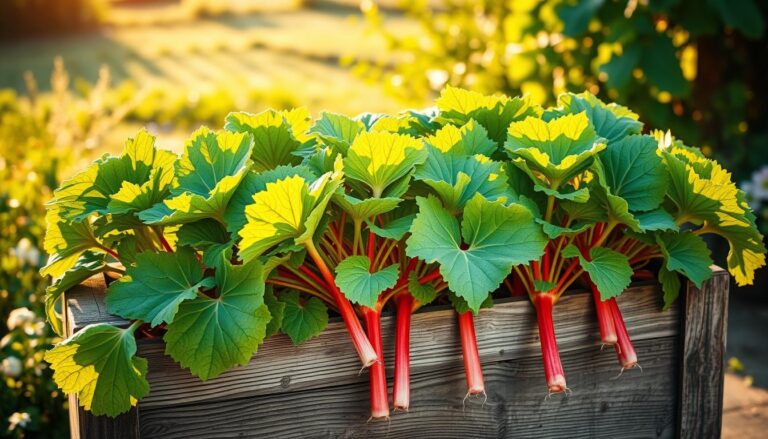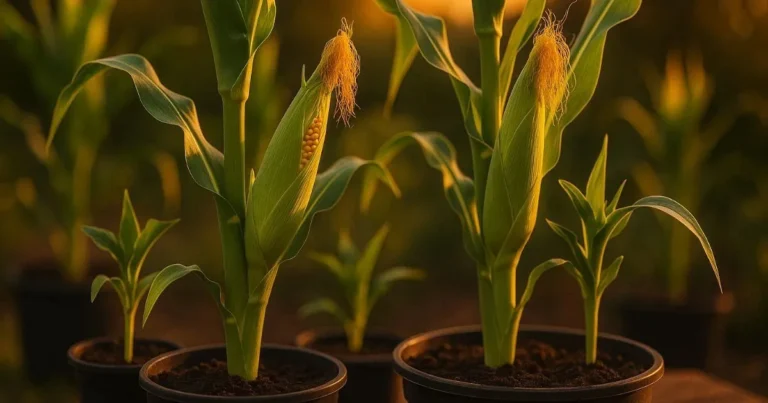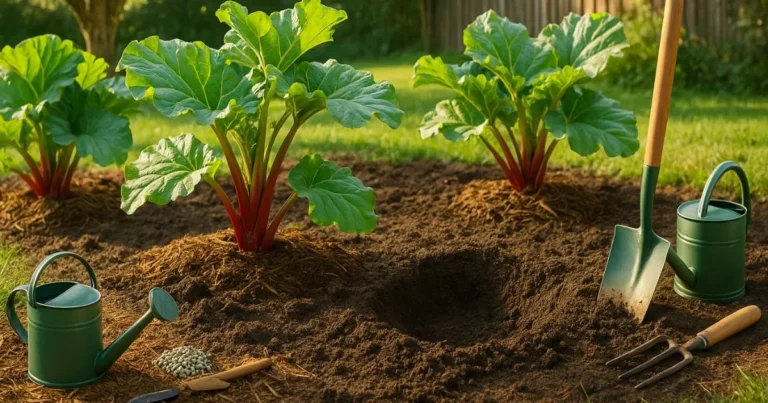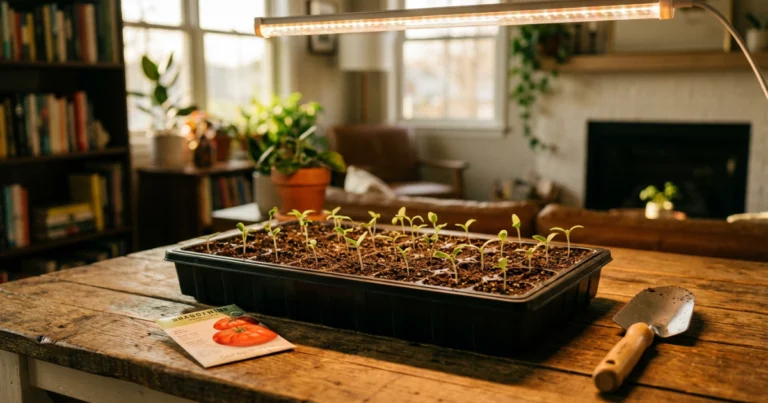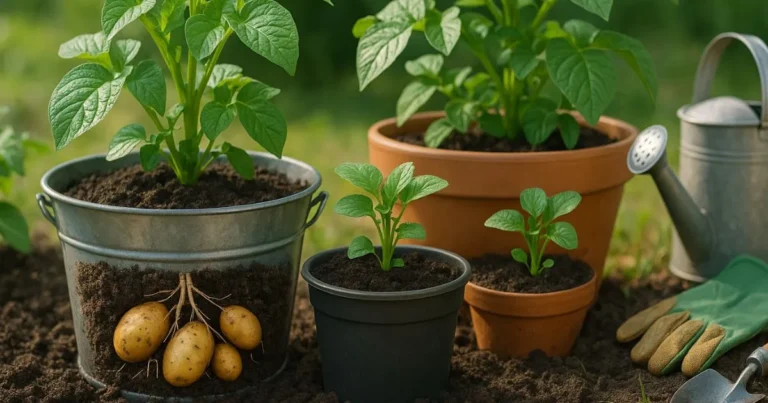Eggplant Growing Tips for a Healthy Harvest
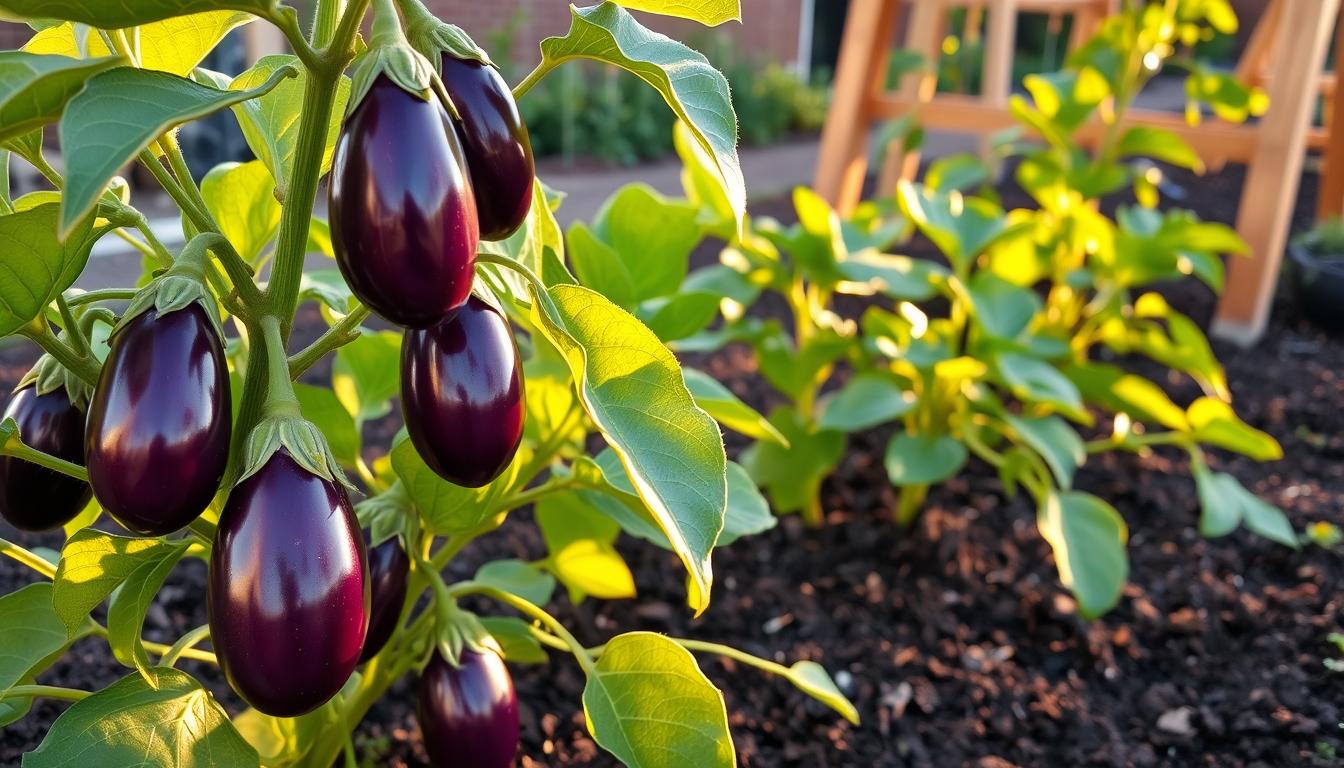
Table of Contents
Eggplant Growing Tips for a Healthy Harvest
To get a lot of eggplants, you need to know how to care for them. Eggplant is a warm-season crop that loves hot weather. It needs lots of sunlight and soil that drains well.
For successful eggplant growing, give them the right conditions. Make sure they get enough sunlight. Also, plant them in soil that drains well to avoid waterlogged soil.
By following these simple yet crucial tips, you’ll be well on your way to enjoying a healthy harvest of delicious eggplants. Proper care will help you maximize your yield and enjoy the fruits of your labor.
Understanding Eggplant Basics
Learning about eggplant growing is key for a good harvest. Eggplants come in many shapes, sizes, and colors. They add variety to any garden.
Eggplant Varieties for American Gardens
Eggplant varieties are many, fitting different climates and growing spots. Pick a variety based on days to maturity and climate needs.
Popular Varieties for Different Climates
‘Black Beauty’ and ‘American Dream’ are top picks for American gardens. They grow well and produce a lot.
Days to Maturity Considerations
Eggplants take 70-90 days to grow after being moved. Picking the right days to maturity helps you harvest before frost.
Climate Requirements and Growing Seasons
Eggplants love warm weather, between 70°F and 85°F. Knowing the climate needs is important for growth.
Temperature Needs for Optimal Growth
Warmth is essential for eggplants. Temperatures under 60°F slow growth, and over 90°F stress them.
USDA Growing Zones for Eggplants
Eggplants grow best in USDA zones 4-12, depending on the type. Make sure to check the zone for the best results.
| Variety | Days to Maturity | USDA Zones |
|---|---|---|
| Black Beauty | 75-85 | 4-8 |
| American Dream | 70-80 | 5-9 |
| Fairy Eggplant | 60-70 | 6-10 |
Knowing these eggplant basics helps you grow better. Good eggplant care and choosing the right variety are key to a bountiful harvest.
Essential Eggplant Growing Techniques
To grow eggplants well, you need to know the right techniques at the right time. Understanding the key aspects of growing eggplants is crucial for a healthy harvest.
When to Plant Eggplants
Planting eggplants at the right time is key. In most areas, start seeds indoors 6-8 weeks before the last frost. This gives seedlings a chance to grow strong before moving outside.
Spring Planting Timeline
Here’s a basic plan for spring planting:
- 6-8 weeks before last frost: Start seeds indoors
- 2-3 weeks before last frost: Harden off seedlings
- After last frost: Transplant seedlings outdoors
Extended Season Strategies
To grow eggplants longer, use row covers or cold frames to protect from frost. Plant eggplants every 2-3 weeks for a steady harvest all season.
Starting Seeds Indoors vs. Direct Sowing
Starting seeds indoors gives you a jumpstart on the growing season. It also lets you control the seedlings’ environment. But, in warmer climates, direct sowing can work well too.
| Method | Advantages | Disadvantages |
|---|---|---|
| Starting Seeds Indoors | Head start on the growing season, better control over seedlings | Requires indoor space, transplant shock |
| Direct Sowing | Less transplant shock, easier for warm climates | Limited control over seedlings, longer time to harvest |
Preparing Your Garden Soil
Eggplants love well-draining, fertile soil with a pH of 5.5 to 7.5. To get your soil ready, mix in compost or well-rotted manure. This improves soil structure and fertility.
Soil pH and Amendment Tips
Check your soil pH often and adjust it if needed. Use lime to raise it or sulfur to lower it. Also, add a balanced fertilizer as directed to feed your eggplants.
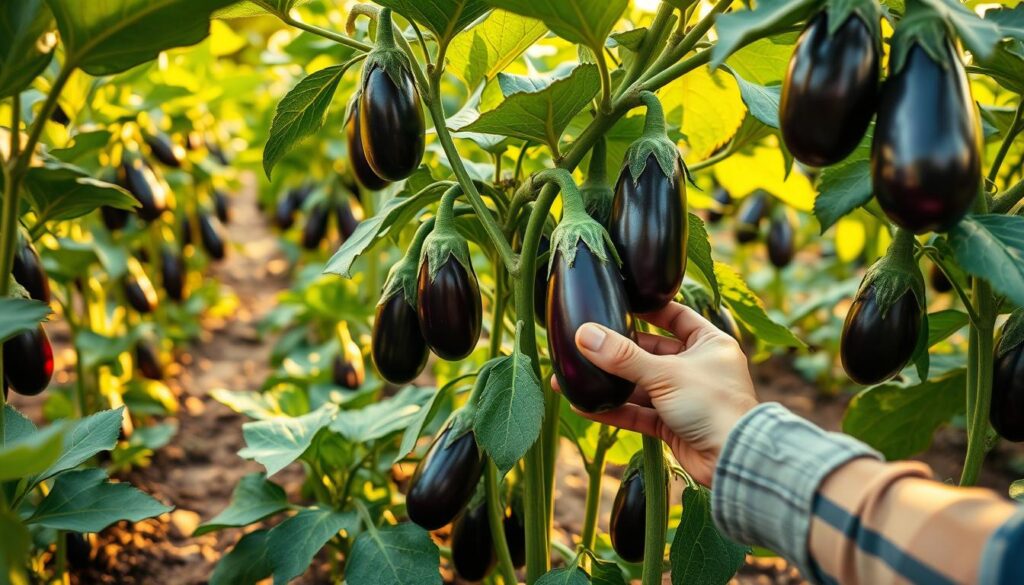
Best Eggplant Varieties for Different Regions
Choosing the right eggplant variety is crucial for a successful crop. There are many types to pick from, each suited to different climates and gardening needs.
Classic Italian and Globe Varieties
Classic Italian and globe eggplants are favorites among gardeners. ‘Black Beauty’ and ‘Black Magic’ are known for their large, shiny fruits. Italian varieties like ‘Rosa Bianca’ and ‘Violetta’ add color and flavor to dishes.
These eggplants do well in temperate climates with warm summers. They need full sun and well-drained soil to grow well.
Asian and Specialty Eggplants
Asian eggplants, like ‘Ichiban’ and ‘Pingtung Long’, are great for stir-fries and grilling. ‘Fairy Tale’ and ‘Hansel’ are perfect for small spaces because they grow compactly.
These eggplants need specific conditions, like warmer temperatures for Asian types. They add variety to your harvest.
Heat-Tolerant and Quick-Maturing Varieties
In hot summers, ‘Dusky’ and ‘Nubia’ eggplants stay quality even in high heat. ‘Early Beauty’ and ‘Orient’ mature quickly, allowing for more harvests.
These are great for gardeners in warm climates or those wanting more eggplants.
By picking the right eggplant variety for your area, you can have a successful harvest. Whether you prefer classic, specialty, or heat-tolerant eggplants, there’s something for everyone.
Planting and Spacing Your Eggplants
To grow eggplants well, knowing how to space them is crucial. The right spacing lets your eggplants get enough sunlight and air. It also keeps diseases away.
Proper Spacing Guidelines
Eggplants need to be 24-30 inches apart for the best growth. This space stops overcrowding. Overcrowding can make your plants more likely to get sick.
Transplanting Seedlings Successfully
When moving eggplant seedlings, be gentle to avoid harming their roots. Harden off the seedlings first. This means slowly getting them used to the outdoors over 7-10 days.
Eggplant Companion Planting Strategies
Companion planting helps your eggplants grow better and stay healthy. The right friends can keep pests away and help your plants grow stronger.
Beneficial Companion Plants
- Marigolds: Repel nematodes and other pests
- Basil: Improves flavor and repels aphids
- Borage: Attracts beneficial insects
Plants to Avoid Near Eggplants
- Potatoes: Share similar disease susceptibilities
- Fennel: Inhibits the growth of many plants
| Companion Plant | Benefit |
|---|---|
| Marigold | Repels nematodes |
| Basil | Repels aphids, improves flavor |
| Borage | Attracts beneficial insects |
By spacing and planting the right companions, you can make your eggplants healthier and more productive.
Essential Eggplant Care Tips
To get a great eggplant harvest, you need to care for them right. This includes watering, fertilizing, pruning, and staking. Learning these tips will help your eggplants grow well.
Watering Requirements and Techniques
Eggplants need steady moisture, more so when they’re fruiting. Give them about 1-2 inches of water per week, from rain or irrigation. Using drip irrigation is best because it waters the roots directly, cutting down on evaporation and runoff.
Drip Irrigation vs. Hand Watering
Drip irrigation saves water and delivers it straight to the roots. But, hand watering works too, if done right. Just avoid getting the leaves wet to stop fungal diseases.
Fertilizing Schedule for Maximum Production
A good fertilizer helps eggplants grow strong. Begin with a nitrogen-rich fertilizer when they’re 6 inches tall. Then, switch to a balanced fertilizer when they start flowering. This helps with leaf growth and fruiting.
Pruning and Staking for Healthier Plants
Pruning and staking are key for healthy eggplants. Take off lower leaves to stop diseases. Staking keeps the fruit off the ground, preventing rot and making picking easier.
Support Systems for Heavy Fruits
Big or heavy fruits need extra support. Use soft ties or clips to hold the fruit to the stake. This keeps it from breaking off.
By using these eggplant care tips, you’ll get a big and healthy harvest. Good care means your eggplants will keep growing well all season.
Organic Eggplant Farming Methods
Adopting organic eggplant farming methods lets you grow healthier food. It also supports sustainable practices. Organic farming uses natural ways to fight pests and diseases. It also improves soil health.

Natural Fertilizers and Amendments
Using natural fertilizers is key in organic eggplant farming. You can use compost, manure, or green manure to make the soil better. These natural helpers give plants the nutrients they need for growth and fruit.
Chemical-Free Pest Management
Chemical-free pest management is vital in organic farming. You can manage pests and diseases with crop rotation, biological control, and cultural controls. This method protects the environment and gives you a healthier crop.
Sustainable Growing Practices
Sustainable growing practices keep the soil healthy and support biodiversity. Two important strategies are:
- Crop Rotation Strategies: Rotating crops breaks disease and pest cycles. It also makes the soil more fertile and structured.
- Mulching Benefits: Mulching keeps moisture in, stops weeds, and controls soil temperature. It makes a better growing space.
By using these sustainable practices in your eggplant farm, you’ll have a more resilient and productive garden.
Eggplant Container Gardening
If you’re short on space for a garden, try container gardening for eggplants. It’s a great way to grow this tasty vegetable.
Choosing the Right Containers
Choosing the right container is key for eggplant gardening. Pick ones that are at least 5-gallons. This size gives the roots enough room to grow.
Size and Material Considerations
Choose containers made from strong materials like plastic or clay. Make sure they have holes for drainage. A good potting mix is vital for healthy roots.
Container Soil Mix and Drainage
The soil mix should hold moisture but drain well. Mix potting soil, compost, and perlite or vermiculite for this. Check the soil moisture often to avoid too much water.
Special Care for Container-Grown Eggplants
Container eggplants need regular food and water. Use a balanced fertilizer every two weeks. Watch for pests and diseases, as they can be a problem.
With these tips, you can grow plenty of eggplants, even in small spaces.
Managing Eggplant Pests and Diseases
To keep your eggplants safe, it’s key to know about common pests and diseases. Early detection is the first step in managing them organically.
Common Eggplant Pests and Prevention
Eggplants face many pests that can harm their growth. Flea beetles, Colorado potato beetles, aphids, and spider mites are some of the most common.
Flea Beetles and Colorado Potato Beetles
Flea beetles make holes in leaves, while Colorado potato beetles can strip plants bare. Using row covers and rotating crops can help stop these pests.
Aphids and Spider Mites
Aphids harm plants by sucking sap and can spread viruses. Spider mites turn leaves yellow. Keeping an eye out and introducing ladybugs can help control these pests.
Identifying and Treating Eggplant Diseases
Diseases like Verticillium wilt and blossom end rot can hurt eggplants a lot. Knowing the causes and symptoms is key to managing them well.
Verticillium Wilt
Verticillium wilt makes leaves wilt and turn yellow. It’s a fungus in the soil. Rotating crops and using resistant plants can help fight it.
Blossom End Rot
Blossom end rot causes fruit to rot at the blossom end. Keeping soil moist and ensuring it has enough calcium can stop this.
| Disease/Pest | Symptoms | Management |
|---|---|---|
| Flea Beetles | Holes in leaves | Row covers, crop rotation |
| Verticillium Wilt | Wilting, yellowing leaves | Crop rotation, resistant varieties |
| Blossom End Rot | Rotting of fruit’s blossom end | Consistent soil moisture, adequate calcium |
Organic Solutions for Pest Management
Organic methods are vital for growing eggplants sustainably. Using natural fertilizers and managing pests without chemicals is important. These practices help keep your crop healthy.
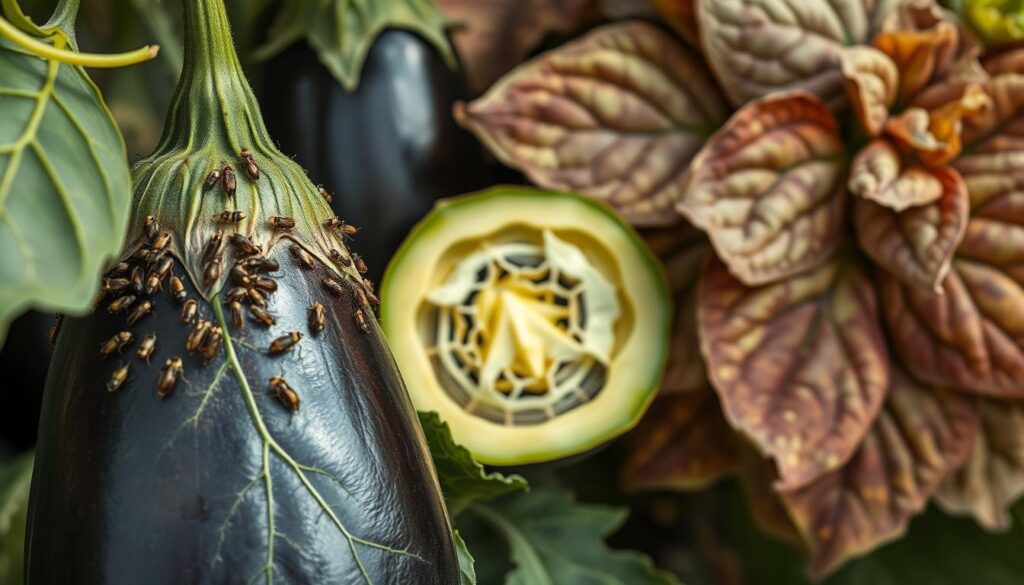
By using these strategies, you can protect your eggplants from pests and diseases. This ensures a healthy and bountiful harvest.
Harvesting and Storing Your Eggplants
It’s time to pick your eggplants after growing them. Picking them at the right time is key for the best taste and texture.
When and How to Harvest Eggplants
Eggplants are ready to pick 65-80 days after you plant them. Check if they’re ripe by looking for these signs:
Signs of Perfect Ripeness
- A glossy and firm skin
- A deep, rich color (varies depending on the variety)
- A slight give when pressed, but still firm enough
Use a sharp knife or pruning shears to cut the eggplant from the plant. Leave a short stem attached. Don’t pull or twist the fruit to avoid harming the plant.
Post-Harvest Handling Tips
Be gentle with your eggplants after picking to keep them fresh. Don’t bruise or scratch the skin, as it can spoil. For immediate use, just wash and dry them.
Storage Methods for Maximum Freshness
To keep eggplants fresh, store them in a cool, dry spot or in the fridge. They last up to a week. For longer, try pickling or freezing them.
| Storage Method | Duration | Notes |
|---|---|---|
| Cool, dry place | 3-5 days | Avoid direct sunlight |
| Refrigerate | Up to 1 week | Keep in a breathable bag |
| Pickling/Freezing | Several months | Follow proper preservation techniques |
Conclusion
Growing eggplants can be very rewarding. With the right knowledge and techniques, you can enjoy a healthy harvest. Understanding the basics, choosing the right variety, and following care tips are key.
To grow eggplants successfully, you need to know about spacing, watering, and fertilizing. You can also try organic farming and container gardening. These methods help manage pests and diseases, leading to a great harvest.
Now, it’s time to put what you’ve learned into action. Pick a variety that fits your area and get your garden ready. With patience and hard work, you’ll soon have fresh eggplants from your garden. Growing eggplants is achievable, and enjoying your own produce is incredibly fulfilling.

